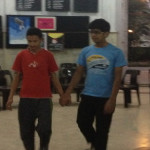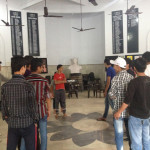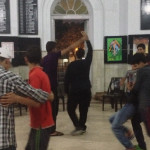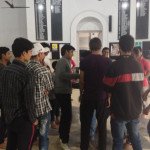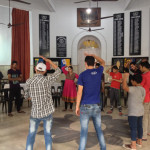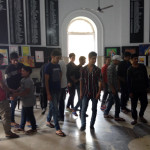Too long a sacrifice
Can make a stone of the heart.
O when may it suffice?
That is Heaven’s part, our part
To murmur name upon name,
As a mother names her child
When sleep at last has come
On limbs that had run wild.
What is it but nightfall?
No, no, not night but death;
Was it needless death after all?
For England may keep faith
For all that is done and said.
We know their dream; enough
To know they dreamed and are dead;
And what if excess of love
Bewildered them till they died?
I write it out in a verse—
MacDonagh and MacBride
And Connolly and Pearse
Now and in time to be,
Wherever green is worn,
Are changed, changed utterly:
A terrible beauty is born.
—‘Easter 1916’, W. B. Yeats
A feeling of unrest and suppressed anger that hovers like a dark cloud over the valley of Kashmir—a residue of over sixty years of conflict—has left the youth scarred and isolated. Background, experiences, lifestyle and exposure atypical to that of their peers in the rest of the country, they are confused about their identities, feel alienated in their own country and have construed biased and negative opinions of all those who belong outside the valley. Dialogue for Peace, for the last seven sessions, has addressed the need to bridge the divide between young people belonging to the same nation.
The seventh session of Dialogue for Peace, conducted at La Martinere for Boys Calcutta, used theatre activities as a medium to bridge this gap. Facilitated by Ramanjit Kaur, the workshop opened with activities to loosen the physical component as a precursor to loosen mindsets simply to open arenas for discussion and questioning—be it jumping over an imaginary ball, passing around very real claps, screaming while playing tag or stretching the physique to previously unexplored limits. The exhaustion made some walls in the mind collapse, supporting the process of introspecting the self. The activity was simple: create a calling card for yourself. Using adjectives for each letter of their names, each of the participants had to choose attributes true to their selves. Interestingly, for most of our guests from the valley, religion featured prominently while choosing an attribute. As a preliminary attempt at being true to oneself and friends to-be, the exercise proved very successful for an intial search within.
The next hour felt as though it was functioning on a different plane. Seated in a large circle within the high-ceilinged, airy chapel each one attributed themselves to one of the four primordial elements. The one word that can summarize most of the responses is fierce. Land had similar expressions akin to being firm, dependable and unbreakable while wind had denotations of happiness, gushing without barriers and being the primeval life source. Water and fire had much stronger and poetic responses. Aamir from Kashmir said this is the reason why he chose water: When I am sparkling, I am an elixir of life. When I am murky, I am a medium of death. The characteristic of water to take the shape of its container was also an oft-repeated reason. With fire, the red of anger and the passion to live attracted Himanshu from La Martinere. For Musaib, fire was the same irrespective of its size. Post the sharing and a deafening silence, the understanding that the prime compositions of existence were the same drifted in. This was followed by an afternoon session filled with theatre activities—exercises to improve skills of observation, build relationships and agility of the mind and body. It was an exhausted yet exhilarated group that ‘YO’ed before dispersing for the day. The English-Hindi/Urdu divide began as a huge chasm dividing the ‘city boys’ from the ‘valley boys’, however, during the course of the workshop, it reduced greatly in size as friendships ruled over.
The second day after a Kashmir versus Calcutta cricket match in which Kashmir won, seven of the eleven students from Kashmir were in absentia when the workshop began. There was an almost visible layer of anger that was radiating from the group who came down to ‘talk’. Having been informed that it was a weeklong tour in Calcutta, the entire workshop was an unpleasant surprise. To an objective observer, the reactions of the angry young men were a perfect study material for pack behaviour. Subconsciously, one person’s anger quickly spread to the group who insisted on packing their bags and leaving by the next train. When the situation seemed to get out of control, the peacekeeping forces—Megha Malhotra from the Seagull Foundation for the Arts and Mr Chakravarthi, Principal, La Martinere for Boys—stepped into the thick of action with a firm stand. Each one had to decide whether they wanted to continue or quit the trip, also keeping in mind the four who enjoyed being a part of the process. Despite all the drama that occurred outside the theatre workshop, it was a lesson well learnt for all of us. As a part of reinforcing individual identity, each of the participants were individually made to ponder on the questions ‘is so much anger required?’ and ‘was it your individual response or did it escalate because of the group’s influence?’ While many felt that the anger was justified since they had been wronged, they did accept that blindly protesting and packing the bags was not the right course of action. This lead to a discussion on thinking and acting for oneself than following what the majority feels right. This subject of logically analyzing and questioning thought processes was repeated throughout the workshop.
While the protests and all the anger were a slight damper on the spirits, the workshop proceeded as per plan. Beginning with exploring expectations for the workshop and feedback on the previous day’s activities, the rest of the day was spent in exercises involving control over the physique, swiftness and politics of life.
‘I was surprised by the way people treated us here. I did not expect this amount of respect and friendliness. I had always thought we would be treated differently.’—Yasir, Kashmir.
‘I signed up because my teacher told me that it would be a good experience. I had also heard about this project from my seniors who had been a part of this project before. Yet I didn’t know what to expect before the start of the session. Now, I know that I will improve my interaction skills, make new friends and learn new things even about myself.’—Aayushman, La Martinere for Boys.
The control-your-movement activities saw the young adults transport to a time where playing meant running around with other kids, shrieking with laughter. The ‘monkey-ness’ generally associated with young boys became more explicit as each of them had a paper tail attached and had to remove others’ tails while protecting their own. Groups were broken as during the process of the game lesser and lesser people remained ‘alive’, the Calcutta and Kashmir loyalty disappeared. The day ended with multiple rounds of ‘Dog and the Bone’ where the boys went back to being young adults as they realized the importance of eye contact in gauging another individual.
The following day passed in a flurry of games. ‘A loves B, B loves C . . . ’ revealed that the future gymnastics gold medalists were present in the workshop. As one tried to catch the ankle of the person to his right, he had to avoid being caught by the person to his left while loudly declaring undying friendship to his neighbour. Followed by rounds of ‘Tom and Jerry’ and a Navarasa-filled Dog and the Bone, the day ended with three ‘improv’ performances keeping ‘picnic’ as the central theme. While two groups made merry the third group had strongly brought in the issue of women’s safety within their 1-minute play.
The last two days of the session passed in a blur. Emphasizing on individuality and courage of conviction, the discussion was also extended to careers and future. The idea of multi perspectives was also brought into the sharing session with the glass of water half-filled or half emptied depending on the way one wanted to approach it. The day concluded with another round of improvisation, this time with ‘wedding’ as it’s central idea. The stories were less simple than the previous day’s attempts and all the groups had managed to fit an entire plot within a performance not exceeding two minutes. The last day of the workshop began after a shopping trip to the New Market. A marked difference was seen in the interaction between the two groups. The total confidence levels of the Kashmir group showed a steady growth. In the last activity of the session, the boys were split into pairs and each had to lead their partner while being blindfolded—the initial round in a walk around the chapel and the second round in a dance. While feelings of complete responsibility and mutual trust were oft-repeated responses to the activity, Basit from Kashmir felt as though he was ‘walking over darkness’. After a splendid dance performance by Shahid and Furqan, the final feedback session was in motion. For most of the strapping young men from the valley, a lot of lessons were learnt both within and outside the workshop. The way the school functions, the openness with which they were included, mutual respect from their peers and the discussions in the workshop, especially the ones on anger had definitely planted seeds of change in their minds. For the La Martinere participants, the experience was an eye opener—be it the established mindsets on ‘boys from Kashmir’ or their own comfort zones, both physically and emotionally. After certificates and immense amounts of camera flashes, it was time for the final YO.
As the group from Kashmir was about to leave the next morning, there weren’t any fond farewells or tears of separation. With smiles, warm hugs and subtle indicators of friendships that would continue, the young men started on their journey back to the valley.
Somewhere, somehow, these twenty young men will always have a place in each other’s hearts.
—Anugraha Madhavan

